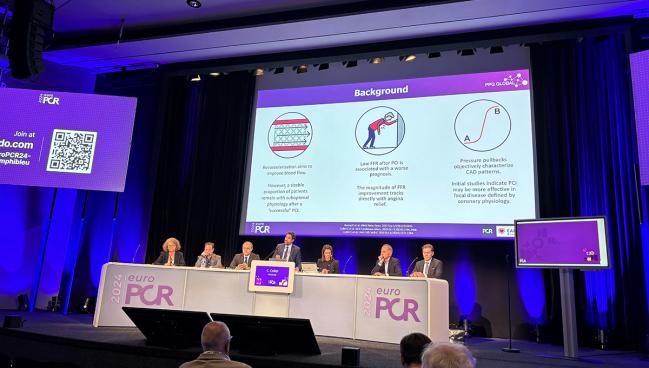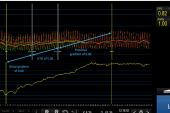FFR-Derived Metric Can Identify Focal CAD Best Suited to PCI
Patients with diffuse disease are less likely to see improvements in flow, data from the PPG Global Registry show.

PARIS, France—Pullback pressure gradient (PPG), a novel metric derived from fractional flow reserve (FFR) pullback, may be a useful tool for assessing which patients with stable coronary artery disease will see the greatest physiological impact from PCI, new results from the PPG Global Registry suggest.
As reported by TCTMD, the same research group previously did a post-hoc analysis of the TARGET-FFR trial that showed PPG appears to be able to identify the CAD patients likely to derive the most symptom relief from PCI.
“When we consider patients with stable coronary artery disease, the goal of revascularization is to improve blood flow,” investigator Carlos Collet, MD, PhD (Cardiovascular Center Aalst, OLV Clinic, Belgium), told attendees here in a late-breaking clinical trial session last week at EuroPCR. But for a “sizeable proportion of patients,” FFR reveals that physiology remains suboptimal even after angiography indicates successful PCI—perhaps due to the presence of diffuse disease.
PPG, he explained, complements FFR by quantifying CAD as focal or diffuse on a scale of 0-1, respectively.
Speaking with TCTMD, Collet noted that every FFR exam should end with a pullback. “In terms of the technology, one of the advantages of the PPG is that basically you are leveraging one of the [existing] steps of the FFR procedure,” he said, adding that before the existence of PPG, “that information was lost.”
In medicine, simply relying on a subjective understanding of a patient’s problem may not be enough, Collet stressed. “You want to help the patient. So if you see something that you think you can fix, you go for it. But sometimes you don’t look at it from the complete picture.” What PPG offers, he said, is the ability to quantify what’s needed.
If you see something that you think you can fix, you go for it. But sometimes you don’t look at it from the complete picture. Carlos Collet
For the investigator-initiated, multicenter PPG Global Registry, Collet and colleagues enrolled 993 patients (n = 1,044 vessels) who were scheduled for PCI and had at least one epicardial lesion with an FFR ≤ 0.80. They performed manual FFR pullbacks to obtain PPG values prior to intervention.
At baseline, the mean FFR was 0.68 and the mean PPG was 0.62. After PCI, the mean FFR was 0.87.
Baseline PPG values significantly correlated with change in FFR after PCI (r = 0.65; 95% CI 0.61-0.69; P < 0.001) and predicted optimal revascularization, defined as a post-PCR FFR ≥ 0.88, with an area under the receiver operating characteristic curve (AUC) of 0.82 (95% CI 0.79-0.84). Baseline FFR alone, however, did not predict the outcomes of revascularization, with an AUC of 0.54 (95% CI 0.50-0.57).
PPG values below a cutoff of 0.62 indicated diffuse disease and higher values indicated focal disease. Most diffuse disease could be found in the LAD (89.6%), whereas just a minority existed in the LCx (3.4%) and RCA (7.0%). For focal disease, the proportions were 55.0%, 20.4% and 24.7%, respectively.
With PCI, the risk of periprocedural MI was nearly doubled in those with diffuse versus focal disease (OR 1.71; 95% CI 1.00-2.97).
Treatment decisions changed for 14% of patients based on PPG values: 5% were referred to CABG and 9% to medical management. “We can conclude now that PPG adds to fractional flow reserve in the decision-making about revascularization in patients with obstructive coronary artery disease,” Collet concluded.
Lesion-Specific Answers
Allen Jeremias, MD (St. Francis Hospital, Roslyn, NY), discussant for the trial, called it “an amazing body of work.”
The study, he said, “addresses a new concept of PCI planning, which I think is really critical, in that the limitations of the coronary angiograms are recognized. And we now have this tool available to us to produce a lesion-specific index to understand the physiologic benefit of PCI in those specific lesions. . . . I think this is going to be the future of how we’re going to be doing PCI, and PCI planning, down the road.”
Jeremias asked panelists what they would do if they had a PPG showing diffuse disease: “Are you planning to stent it, to send to surgery, to treat medically? What do you think the best approach is?”
In reply, Bernard de Bruyne, MD, PhD (Cardiovascular Research Center Aalst), predicted that based on how operators in the PPG Global Registry responded to knowing PPG, “this will definitely influence the way we are selecting patients to undergo PCI.” In patients with diffuse disease, he added, “we cannot help them that well with PCI.”
For panelist Alexandra Lansky, MD (Yale School of Medicine, New Haven, CT), the answer of what to do when PPG indicates diffuse disease is “going to be all of the above—I think it’s going to be pharmacology plus procedural technique.” But it also makes sense in these instances to use invasive imaging, though this means “now we’re tiering on multiple modalities,” she noted.
Collet acknowledged there is a learning curve—and much left to be understood—about refining decisions about PCI in the context of disease patterns.
Through the EuroPCR app, a meeting participant asked when PPG, currently a research tool, would be commercialized. Collet said that answer lies with the company Coroventis, though it could be in early 2025.
Next up, Collet told TCTMD, they will embark on the PPG Primetime, slated to launch next year. In the study, patients will be randomized to a PPG-guided strategy—where those with high PPG will receive PCI and those with low PPG, even if they have low FFR, will receive medical therapy—or to standard of care.
Caitlin E. Cox is News Editor of TCTMD and Associate Director, Editorial Content at the Cardiovascular Research Foundation. She produces the…
Read Full BioSources
Collet C, Munhoz D, Mizukami T, et al. Influence of pathophysiological patterns of coronary artery disease on immediate percutaneous coronary intervention outcomes. Circulation. 2024;Epub ahead of print.
Disclosures
- The study was sponsored by the Cardiovascular Research Institute (CRI) Aalst with an unrestricted grant from Abbott Vascular.
- Collet reports institutional support from Abbott Vascular, HeartFlow, GE Healthcare, Shockwave Medical, Boston Scientific, Insight Lifetech, Pie Medical, and Medis Medical Imaging; equity/stock options with Medyria and Xenter; and consultancy fees from Abbott Vascular, HeartFlow, GE Healthcare, Boston Scientific, Insight Lifetech, EarlyBird, Pfizer, Siemens, and Shockwave Medical.





Comments